ARTICLE
ABSTRACT
The present paper is concerned with the comparison of the nephropathy onset time of type-2 diabetic patients, grouped on the basis of gender and age at the time of diabetes diagnosis. Diabetic Nephropathy (DN) onset time is assumed to follow Weibull distribution with fixed left truncation. The likelihood ratio test is applied on uncensored cases and Thoman and Bain two sample tests is applied with generated left truncated Weibull distributions. To avoid the model validity issues for left truncated and right censored data (LTRC), the nonparametric approach, suggested by Kaplan and Meier, is used to compare the survival function of two groups over different time periods. Another method based on median survival time of the pooled group is applied to compare the survival function of two groups with LTRC data. The major advantage of developing methods for comparing the nephropathy onset times of DM patients is that the expected DN onset time of new DM patients can be predicted depending on the patient group.
KEYWORDS
Kaplan-Meier survival function; survival time; Weibull distribution
REFERENCES
ASHFAQ, S., GHAZZAL, Z. DOUGLAS, J. S., MORRIS, D. C., VELEDAR, E., WEINTRAUB, W. S., (2006). Impact of diabetes on five-year outcomes after vein graft interventions performed prior to the drug-eluting stent era. The journal of invasive Cardiology, 16(3), pp. 100–105.
COLLETT, D., (2003). Modeling survival data in medical research. 2nd ed. London: Chapman and Hall/CRC.
CZEKALSKI, S., (2005). Diabetic nephropathy and cardiovascular diseases. Annales Academiae Medicae Bialostocensis, 50, pp. 122–125.
FELLINGER, E. K., LEAVITT, B. J., HEBERT, J. C., (2002). Serum levels of prophylactic cefazolin during cardiopulmonary bypass surgery. Ann. Thorac. Surg., 74, pp. 1187–1190.
GROSS, J. L., DE AZEVEDO, M. J., SILVEIRO, S. P., CANANI, L. H., CARAMORI, M. L., ZELMANOVITZ,T., (2005). Diabetic nephropathy: diagnosis, prevention, and treatment. Diabetes Care, 28, pp. 164–176.
JOSS, N., PATERSON, K. R., DEIGHAN, C. J., SIMPSON, K. AND BOULTON JONES, J. M., (2002). Survival Analysis Techniques for Censored and Truncated data. 2nd ed. Springer Science Business Media Inc.
LAM, R. AND SPELT, J. K., (2007). Comparison of Weibull Small Samples using Monte Carlo Simulations. Quality and Reliability Engineering International, 23, pp. 503–513.
LEE, E. T., WANG, W. Y., (2003). Statistical Methods for Survival Data Analysis, 3rd ed. New Jersey: John Wiley & Sons.
LI, Q. H., LAGAKOS, S. W., (1995). Use of the Wei-Lin-Weissfield Method for the Analysis of a Recurring and a Terminating Event. Statistics in Medicine, 16, pp. 925–940.
PEPE, M. S., FLEMING,T. R., (1989). Weighted Kaplan-Meier Statistics: A Class of Distance Tests for Censored Survival Data. Biometrics; 45(2), pp. 497–507.
ROSSING, P., TARNOW, L., NIELSEN, F. S., BOELSKIFTE, S., BRENNER, B. M., PARVING, H-H., (1995). Short stature and diabetic nephropathy. BMJ, 310, pp. 525–528.
THOMAN, D. R. BAIN, L. J., (1969). Two sample tests in the Weibull Distribution. Technometrics, 11 (4), pp. 805–815.
VILLAR, E., CHANG, S. H., MCDONALD, S. P., (2007). Incidences, Treatments, Outcomes, and Sex Effect on Survival in Patients With End-Stage Renal Disease by Diabetes Status in Australia and New Zealand (1991–2005). Diabetes Care, 30 (12), pp. 3070–3076.
VISWANATHAN, V., (2004). Prevention of diabetic nephropathy: A diabetologist’s perspective. Indian J. Nephrol, 14, pp. 157–162.
WILD, S., GREEN, G. A., SICREE, R., KING, H., (2004). Global prevalence of diabetes: Estimates for the year 2000 and projections for 2030. Diabetes Care, 27, pp. 1047–1053
